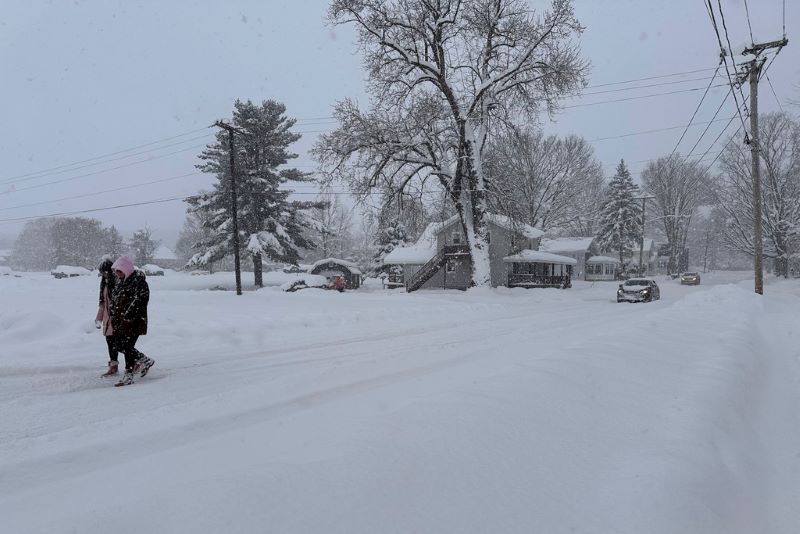As the Thanksgiving holiday draws to a close, parts of the U.S. have been hit hard by snowstorms and severe cold weather. Especially in the Northeast and Midwest, intense lake-effect snow and cold temperatures made it challenging for local people and tourist activities. However, these extremes also brought fun for skiers and snowmobilers, while fans prepared to watch NFL games in the cold, demonstrating people’s resilience and ability to adapt.
Lake-effect snow poses challenges
According to the Associated Press, the Tug Hill area and the Barnes Point region of upstate New York have been affected by intense lake effect snow. Lake effect snow is a band of intense snowfall that forms over land when warm, moist air blows across a lake and meets cold air. Snowfall in the Tug Hill area can be up to several feet at a time, while snow accumulations in the Barnes Point area have reached 46 inches (about 117 centimeters). “We just have to keep clearing”, said local businessman Kevin Teo, who, like other residents, has installed snow removal shovels on his truck and has snow plowing tractors and snow blowers on hand to deal with the ongoing snowfall.
Local governments and the business community have also taken emergency measures in response to the weather disaster. The military at Fort Drum near Watertown, N.Y., has issued a warning that 19 inches of snow is expected to fall during the day Sunday. And in Western New York, a 134-mile stretch of I-90 remains closed to commercial vehicles due to excessive snow.
NFL games and the test of snow and ice
Despite the blizzard, the Buffalo Bills’ NFL game remains on schedule. The team will face the San Francisco 49ers at Orchard Park on Sunday night. In response to the extreme weather, the Buffalo Bills have recruited snow clearers for the game and are providing them with a $20-an-hour paycheck, food, and hot beverages to make sure the game goes off without a hitch.
Lake-effect snow had already hit near the Bills’ home field on Saturday, and the snowfall continued on game day. According to the New York State Weather Risk Communications Center, the amount of snowfall will depend on the duration and direction of the band of snowfall, which could affect weather conditions on game day and put spectators and participants to the test. For residents of cold cities like Buffalo, snowstorms are not just a part of the winter season; they have become a regular part of life. Nonetheless, local fans remain enthusiastic and the inconvenience of the blizzard does not seem to diminish their anticipation for the race, but rather adds a unique challenge and atmosphere to the event.
Cold weather affects a wide range of areas

In addition to the blizzard, frigid temperatures have affected several regions of the United States. Last week’s cold snap left temperatures in the Northern Plains generally 10 to 20 degrees Fahrenheit (about -12°C to -7°C) below average. The cold weather is expected to further cover the eastern third of the United States on Monday, especially in Erie, Pennsylvania, where nearly 2 feet (60 centimeters) of snow fell due to lake-effect snow and created “hazardous” road conditions. In response to the storm, Pennsylvania Governor Josh Shapiro has signed a disaster emergency declaration declaring a state of emergency.
In Michigan, lake-effect snow also caused heavy snowfall in some areas, especially in the Upper Peninsula near Lake Superior, where more than 2 feet (about 60 centimeters) of snow accumulated. In Gaylord, a single-day snowfall record was set on Friday with 24.8 inches (about 63 centimeters) of snow. All of this has certainly created quite a challenge for local residents and the tourism industry. Nonetheless, Michigan residents have long been accustomed to such severe weather conditions, and they have accumulated a wealth of experience in clearing snow and coping with the cold, and many local emergency response systems have demonstrated their efficiency and resilience in the face of this blizzard.
Holiday cheer in Appalachia
In addition to the snowstorms in the Northeast and Midwest, eastern Kentucky and West Virginia also saw a small amount of snowfall, and these flurries added to the winter spirit of the holiday season. While the snowpack was not severe, it still gave road maintenance crews a chance to practice making sure the roads are clear and safe. Overnight lows in Appalachia are expected to drop to 10 to 20 degrees Fahrenheit (about -12°C to -7°C) over the next few days, continuing to push the limits of cold tolerance for local populations.
At the same time, the snowfall is giving residents of this region a special holiday spirit as they prepare for Christmas. For some businesses and people, the snowfall provided the perfect backdrop, with Christmas decorations in stores and on the streets looking particularly cozy and romantic against the snow. Despite the inconvenience that the cold weather brings to transportation and daily life, many people still enjoy the unique charm and fun of the season.
Large-scale response and community cooperation
Snowstorms and severe cold weather not only pose challenges to individual and family life, but also test the emergency response capabilities of governments and communities. In New York, West Virginia and Pennsylvania, many local governments have activated their emergency response plans, including closing some traffic arteries, mobilizing snow removal vehicles, and providing temporary shelters for residents in dire need of help. In addition, many local electric utilities are battling strong winds and snow to ensure that residents do not experience prolonged power outages as a result of the storm. The spirit of mutual assistance in the community is especially important for the elderly, the disabled, and families without emergency preparedness.
In the face of these severe weather events, the solidarity and mutual aid of the population has also become an important theme of the season. In many places, neighbors volunteered to help clear snow, check on the living conditions of elderly people living alone, and even provide hot food and drinks to families in need. This spirit of social cooperation and mutual assistance is especially valuable in the face of a raging snowstorm, adding a warm human touch to the response to natural disasters.
Conclusion
The blizzard and frigid weather brought the power of winter to several regions of the United States and demonstrated the resilience and perseverance of people in extreme weather conditions. While the blizzard caused considerable problems with transportation, daily life, and outdoor activities, it also provided ideal skiing conditions for skiers and an unusual seasonal experience for fans. In the face of such natural challenges, residents across the U.S. remained steadfast and cooperated in dealing with this winter storm. From local governments to ordinary citizens, everyone played their own important role in this winter ordeal. The difficulties brought about by the storm may have been unavoidable, but it also proved once again the resilience and solidarity of people in the face of adversity.












